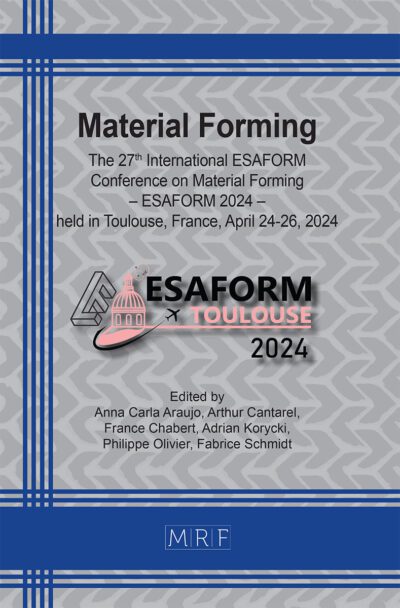A quantitative assessment of variability in impact polypropylene mechanical recycling
Henda MRABTI, Gaël COLOMINES, Sophie QUILLARD, Yves BÉREAUX
Abstract. Plastic recycling has become an environmental and economic necessity. Mechanical recycling by extrusion and injection molding is the preferred method for thermoplastics recycling, owing to its energy efficiency and capacity to process large quantities of plastic solid waste at an industrial scale. For a sustainable plastics economy, it is crucial that mechanical recycling produces high-performance products, even from waste of variable quality. In this context we evaluated the performance of a recycled Impact copolymer polypropylene (PPc), considering a wide range of properties such as dimensions, chemical composition, morphology, melt viscosity, and appearance like color, and mass, as well as mechanical properties such as flexural strength and Charpy Impact resistance. This study highlights that reprocessing leads to changes in color, including a gradual shift from white to light yellow with successive injection molding cycles. A reduction in bulk density is also observed during the transition from pellets to reground flakes. Furthermore, significant chain scission in PP becomes evident from the first reprocessing cycle, reflected in increasing melt flow index (MFI) values. However, the recycling process does not alter the weight of the specimens molded.
Keywords
Mechanical Recycling, Polymer Recycling, Material Degradation, Injection Molding, Polypropylene Copolymer Impact
Published online 5/7/2025, 10 pages
Copyright © 2025 by the author(s)
Published under license by Materials Research Forum LLC., Millersville PA, USA
Citation: Henda MRABTI, Gaël COLOMINES, Sophie QUILLARD, Yves BÉREAUX, A quantitative assessment of variability in impact polypropylene mechanical recycling, Materials Research Proceedings, Vol. 54, pp 2399-2408, 2025
DOI: https://doi.org/10.21741/9781644903599-259
The article was published as article 259 of the book Material Forming
![]() Content from this work may be used under the terms of the Creative Commons Attribution 3.0 license. Any further distribution of this work must maintain attribution to the author(s) and the title of the work, journal citation and DOI.
Content from this work may be used under the terms of the Creative Commons Attribution 3.0 license. Any further distribution of this work must maintain attribution to the author(s) and the title of the work, journal citation and DOI.
References
[1] B. Mrowiec, ‘Sciendo’, Environ. Prot. Nat. Resour., vol. 29, no. 4, pp. 16–19, Dec. 2018. https://doi.org/10.2478/oszn-2018-0017
[2] S. Saikrishnan, D. Jubinville, C. Tzoganakis, and T. H. Mekonnen, ‘Thermo-mechanical degradation of polypropylene (PP) and low-density polyethylene (LDPE) blends exposed to simulated recycling’, Polym. Degrad. Stab., vol. 182, p. 109390, Dec. 2020. https://doi.org/10.1016/j.polymdegradstab.2020.109390
[3] ‘Plastics – the Facts 2022 • Plastics Europe’, Plastics Europe. Accessed: Dec. 03, 2024. [Online]. Available: https://plasticseurope.org/knowledge-hub/plastics-the-facts-2022-2/
[4] J. Maris, S. Bourdon, J.-M. Brossard, L. Cauret, L. Fontaine, and V. Montembault, ‘Mechanical recycling: Compatibilization of mixed thermoplastic wastes’, Polym. Degrad. Stab., vol. 147, pp. 245–266, Jan. 2018. https://doi.org/10.1016/j.polymdegradstab.2017.11.001
[5] L. Incarnato, P. Scarfato, and D. Acierno, ‘Rheological and mechanical properties of recycled polypropylene’, Polym. Eng. Sci., vol. 39, no. 4, pp. 749–755, 1999. https://doi.org/10.1002/pen.11463
[6] L. Douiri, H. Jdidi, S. Kordoghli, G. El Hajj Sleiman, and Y. Béreaux, ‘Degradation indicators in multiple recycling processing loops of impact polypropylene and high density polyethylene’, Polym. Degrad. Stab., vol. 219, p. 110617, Jan. 2024. https://doi.org/10.1016/j.polymdegradstab.2023.110617
[7] N. Bahlouli et al., ‘Recycling effects on the rheological and thermomechanical properties of polypropylene-based composites’, Mater. Des., vol. 33, pp. 451–458, Jan. 2012. https://doi.org/10.1016/j.matdes.2011.04.049
[8] L. Incarnato, P. Scarfato, D. Acierno, M. R. Milana, and R. Feliciani, ‘Influence of recycling and contamination on structure and transport properties of polypropylene’, J. Appl. Polym. Sci., vol. 89, no. 7, pp. 1768–1778, 2003. https://doi.org/10.1002/app.12168
[9] D. Jubinville, E. Esmizadeh, C. Tzoganakis, and T. Mekonnen, ‘Thermo-mechanical recycling of polypropylene for the facile and scalable fabrication of highly loaded wood plastic composites’, Compos. Part B Eng., vol. 219, p. 108873, Aug. 2021. https://doi.org/10.1016/j.compositesb.2021.108873
[10] J. Tocháček, J. Jančář, J. Kalfus, P. Zbořilová, and Z. Buráň, ‘Degradation of polypropylene impact-copolymer during processing’, Polym. Degrad. Stab., vol. 93, no. 4, pp. 770–775, Apr. 2008. https://doi.org/10.1016/j.polymdegradstab.2008.01.027
[11] J. Aurrekoetxea, M. A. Sarrionandia, I. Urrutibeascoa, and M. Ll. Maspoch, ‘Effects of recycling on the microstructure and the mechanical properties of isotactic polypropylene’, J. Mater. Sci., vol. 36, no. 11, pp. 2607–2613, Jun. 2001. https://doi.org/10.1023/A:1017983907260
[12] H. S. Ji and H. W. Jung, ‘Effect of the multiple injection process on the structural and mechanical properties of PP impact copolymers focusing on the deformation of ethylene-propylene copolymer’, Polym. Test., vol. 124, p. 108051, Jul. 2023. https://doi.org/10.1016/j.polymertesting.2023.108051
[13] N. Hp, ‘Polypropylene C715-12N HP’
[14] C. Spicker, N. Rudolph, I. Kühnert, and C. Aumnate, ‘The use of rheological behavior to monitor the processing and service life properties of recycled polypropylene’, Food Packag. Shelf Life, vol. 19, pp. 174–183, Mar. 2019. https://doi.org/10.1016/j.fpsl.2019.01.002.
[15] C. Hongjun, L. Xiaolie, C. Xiangxu, M. Dezhu, W. Jianmin, and T. Hongsheng, ‘Structure and properties of impact copolymer polypropylene. II. Phase structure and crystalline morphology’, J. Appl. Polym. Sci., vol. 71, no. 1, pp. 103–113, 1999. https://doi.org/10.1002/(SICI)1097-4628(19990103)71:1<103:AID-APP13>3.0.CO;2-5
[16] T. Furukawa et al., ‘Molecular Structure, Crystallinity and Morphology of Polyethylene/Polypropylene Blends Studied by Raman Mapping, Scanning Electron Microscopy, Wide Angle X-Ray Diffraction, and Differential Scanning Calorimetry’, Polym. J., vol. 38, no. 11, pp. 1127–1136, Nov. 2006. https://doi.org/10.1295/polymj.PJ2006056
[17] T. Andersson, B. Stålbom, and B. Wesslén, ‘Degradation of polyethylene during extrusion. II. Degradation of low-density polyethylene, linear low-density polyethylene, and high-density polyethylene in film extrusion’, J. Appl. Polym. Sci., vol. 91, no. 3, pp. 1525–1537, 2004. https://doi.org/10.1002/app.13024













